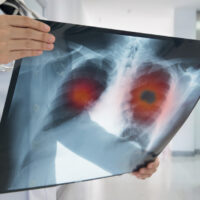What is Colon Cancer?
Colon Cancer is a type of Cancer where the inner wall of colon tissue cells become malignant/cancerous. The colon, most commonly called the Large Intestine, is a part of the body’s digestive system which processes nutrients from the food. Colon Cancer is also commonly referred to as Bowel Cancer. When the rectum is also involved, it is called Colorectal Cancer involving both the colon and rectum.
Most colon cancer develops from polyps that are small and noncancerous(benign). Thus, regular testing and removing polyps aids in the early detection and prevention of colon cancer.
Symptoms of Colon Cancer
3 main symptoms of Colon Cancer are:
- Persistent blood in stools: Rectal bleeding with bright red blood
- Persistent change in bowel habits: Increased frequency of passing stools and even runny stools (diarrhea), or constipation, bowel incontinence or even persistent change in stool consistency that lasts for many days.
- Persistent abdominal pain: Tummy pain, bloating and discomfort are commonly associated with unintentional loss of weight and loss of appetite.
Other symptoms can be feeling that the bowel doesn’t empty completely, weakness or fatigue and even unexplained anemia.
Types of cancer in the colon and rectum
Most common type of colorectal cancer is Adenocarcinomas which form within the cells that make the mucus in either colon or rectum. Other less common types are:
- Lymphomas: form in the lymph nodes
- Carcinoids: start in hormone-making cells within the intestine
- Sarcomas: form in soft tissues such as muscles in the colon
Causes & Risk Factors
Causes of colon cancer remain uncertain but are generally believed to develop when mutations occur in the DNA of the colon cells that make them cancerous and grow out of control.
Risk factors are identified as below:
- Old age: A majority of people are diagnosed with colon cancer over 50 years of age
- African-American race: African-Americans are at greater risk of developing colon cancer
- Personal history of colorectal cancer or polyps: Colon polyps are known to be a predisposing risk factor for colon cancer
- Inflammatory intestinal conditions: IBD(Inflammatory Bowel Disease) like Ulcerative colitis or Crohn’s disease or any other chronic inflammatory colon diseases possess a high risk for colon cancer
- Family history: Known cases of colon cancer as a blood relative put one at greater risk for colon cancer
- Inherited syndromes: Familial adenomatous polyposis (FAP) and Lynch syndrome/hereditary nonpolyposis colorectal cancer (HNPCC) are the most common inherited syndromes causing risk for developing colon cancer.
- Type 2 diabetes: Colon cancer and type 2 diabetes both share some common risk factors like being overweight and physical inactivity, all leading to a high risk of developing colon cancer
- Low-fiber, high-fat diet: Research has proved increased risk of colon cancer in people who consume high red meat and processed meat diets.
- Smoking: Long term smokers are more prone to develop colon cancer than those who don’t smoke.
- Alcohol: Heavy alcohol use is found to be associated with an increased risk of developing colon cancer.
Stages of Colon Cancer
Stage 0 to 4 wherein Stage 0 represents the early stage and Stage 4 is the most advanced stage.
| Stages | |
| 0 (carcinoma in situ) | Abnormal cell growth is found limited only in the colon or rectal inner lining. It is just in the lesion formation in the precancerous stage. Removal of lesions by polypectomy/ colonoscopy/ surgery is the preferred treatment in this stage. |
| 1 | Cancer penetration is found in the lining or mucosa of the colon or rectum. It may have grown into the muscle layer but hasn’t spread to nearby lymph nodes or other parts. Resection, depending on the location of the lesion, is the treatment option in this stage. |
| 2 | Cancer spread is seen into the colon or rectum walls or through walls to nearby tissues but hasn’t affected lymph nodes. Resection combined with chemotherapy is the preferred method. |
| 3 | Cancer has now spread to the lymph nodes but not to other body parts. Surgery followed by chemotherapy and radiation therapy is necessary at this stage. |
| 4 | The cancer spreads to other distant organs like the liver or lungs. Due to metastases of cancer, surgery is not an option. Other options like chemotherapy, radiation therapy, or both are used in combination. |
Diagnosis
- Colonoscopy: Examination of the large intestine using a colonoscope which is a long, flexible, slender tube attached to a video camera. Passed through the rectum, it can be used to look into the rectum and colon. The doctor may also use it to take biopsy samples for analysis and removal of polyps with tools.
- Virtual Colonoscopy: It is a special examination for the colon using a CT scan. It is less invasive than the traditional colonoscopy and is less discomfort to patients. A radiologist can look for small polyps or growths inside the colon.
- Blood test: Complete blood tests, tumour markers and liver enzymes are generally tested. Carcinoembryonic antigens or CEA can be found in blood tests which are particularly produced by colon cancers.
- Colon barium enema examination: The large intestine, including the rectum, is imaged on the X-ray film by using a liquid suspension called Barium Sulfate(Barium) to fill in the colon. Barium highlights the areas for a clearer picture.
- Fecal Occult Blood Test (FOBT): A sample of stool is observed under a microscope for blood. Blood in the stool could be an indicator of polyps, cancer, or other colon conditions.
- Sigmoidoscopy: A flexible sigmoidoscopy uses a long, thin, flexible tube called a sigmoidoscope which has a camera and light attached at its end. The camera relays images to the monitor. It is particularly useful to see the sigmoid colon.
Treatment
1. Surgery
In early stages
- Polypectomy: Done with colonoscopy on small, localized polyps
- Endoscopic mucosal resection: A small amount of intestinal colon lining is also removed along with larger polyps in this method using colonoscopy
- Laparoscopy surgery: Incisions are made via the abdominal wall for removal of polyps when colonoscopy cannot remove the polyps owing to their location
In advanced cancers
- Partial colectomy: A part of the colon along with a margin of normal tissue on either side of cancer is removed. It can be done via laparoscopy for minimal invasion
- Colostomy: Involves creating an opening in the abdominal wall from the remnant bowel for stool elimination and fixing in a bag at the opening to collect the stool
- Lymph node removal: Nearby affected lymph nodes are excised
2. Chemotherapy: Drugs are used to kill the cancer cells to prevent spread or recurrence or shrink the cancer cells before surgery
3. Radiation therapy: Uses X-ray and protons to kill cancer cells. It is used in combination with chemotherapy and surgery. Radiation therapy can be external beam or internal by placing radioactive catheters near the affected area.
4. Targeted therapy: Targeted drugs are used along with chemotherapy to block particular cell abnormalities.
5. Immunotherapy: Uses a patient’s immune system to ward off cancer cells. Inhibitors are used to attach to the proteins found on cancer cell surfaces and enable T cells to kill cancer cells. Particularly, it is used in metastatic colorectal cancer.
Prevention
Lifestyle changes that can be adopted to reduce the risk of colon cancer:
- Increasing dietary intake of fibres such as whole grains, pulses, fruits and vegetables
- Reducing consumption of red and processed meat such as sausage, harm, bacon, and luncheon
- Performing regular exercise: Minimum of 150 mins of moderate-intensity aerobic physical activity like climbing stairs or brisk walking
- Maintain healthy body weight with an ideal BMI between 18.5 and 22.9
- Refrain from smoking and drinking
- Avoiding non-steroidal drugs(NSAIDs): Studies show that people who take regular aspirin or NSAIDs like ibuprofen, and naproxen are at higher risk of developing colon cancer
- Having enough calcium, vitamin D and in fact multivitamins with folate: Some studies have found a deficiency in calcium and vitamin D to be associated with a high risk of developing colon cancer. A recommended quantity of calcium is 1,000-1,200 mg per day and about 1,000 IU per day of vitamin D intake. A multivitamin pill along with folate is suggested to reduce the risk of developing colon cancer
FAQs
The 5-year survival rate of people with localized stage colon cancer is 91%. Cancer that has spread to surrounding tissue, or organs/regional lymph nodes has a 5-year survival rate of 72%. Cancer that has spread to distant body parts has a 14% 5-year survival rate. The overall 5-year survival rate is calculated to be 63%.
People over 50 years of age are considered to be at risk of colon cancer and are highly recommended for screening.
- 1NCBI
- 2National Cancer Institute
- 3NHS
- 4Medicine Net
- 5American Cancer Society - Symptoms
- 6Mayo Clinic
- 7Cleveland Clinic
- 8Healthline
- 9American Cancer Society - Risk Factors
- 10Johns Hopkins Medicine
- 11Cancer.Net
- 12Medical News Today





